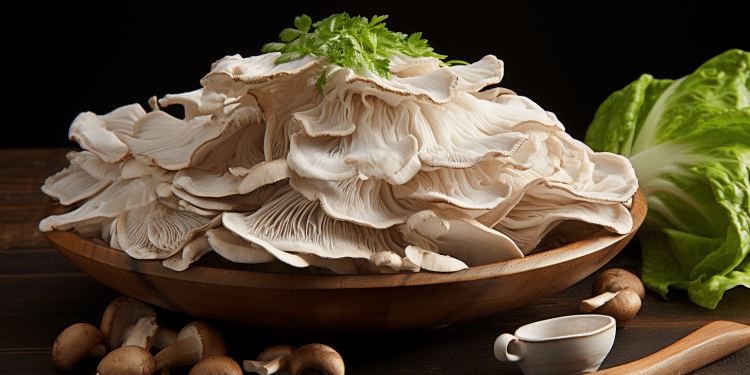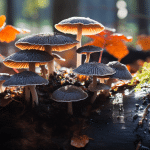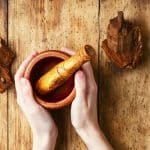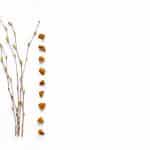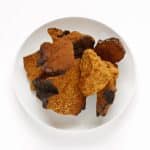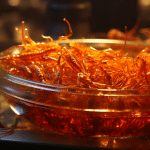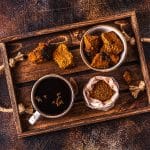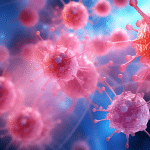Have you been curious about Oyster Mushrooms? Maybe you would like to try and find a few oyster mushrooms growing in the wild around your neighborhood. Or perhaps you simply want to see what they taste like before deciding to purchase a bag of them at the supermarket.
This post is meant to be your comprehensive guide to Oyster Mushrooms. By the time you are done reading this, hopefully all your questions regarding oyster mushrooms will have been answered!
What Are Oyster Mushrooms?
Oyster mushrooms are one kind of edible fungus. They are among the most commonly consumed mushrooms worldwide. They are named for their oyster-shaped caps and their very short (or entirely missing) stalks.
They are also akin to the color of raw oysters. Oyster mushrooms are usually light gray to grayish-brown in color. However, they are available in several other colors, including yellow and pink!. They are one of the easiest types of mushrooms to grow because of their quick growth, a large selection of potential substrates, and their tolerance for growing conditions. Interested to see an oyster mushroom farm in action?
The History of Oyster Mushrooms
Fresh oyster mushrooms have been cultivated commercially since the 1940s. They are available at many markets worldwide, coming in a variety of sizes and colors. Different types of oyster mushrooms are found all over the world, including the United Kingdom and Ireland, much of continental Europe, Asia, and parts of North America.
Oyster mushrooms were first formally documented in 1775 by Dutch naturalist, Nicholas Joseph Freiherr von Jacquin. The mushrooms were initially classified as Agaricus ostreatus. In those days, most mushrooms that had gills were grouped together in the genus Agaricus. In 1871, a German mycologist named Paul Kummer moved oyster mushrooms into its own genus called Pleurotus, which has remained the scientific name of oyster mushrooms until the present day.
When Are Oyster Mushrooms In Season?
In the wild, you may be able to find oyster mushrooms during fall. The best times are after the first freeze of the year, or after some other major weather shift, such as the first warm weekend in the spring. Commercial growers harvest oyster mushrooms year-round, so as long as your supermarket has them, they are always available. Most oyster mushrooms are grown indoors in controlled conditions, so there is not as much of a good or bad season as with some other crops.
Where Can I Find Wild Oyster Mushrooms?
In the wild, oyster mushrooms form colonies called shelves in decaying logs or fallen trees. So, if you do find one, you are likely to find an entire bunch of them, all near each other. Cultured oyster mushrooms tend to grow more individually, but they still will frequently form big clumps.
Look for stumps, downed trees, or a tree that is standing still as potential home sites for oyster mushrooms. Also make sure to look under trees that are falling over, because oysters generally like to grow in the shade.
They tend to especially enjoy growing on oaks and beech trees in older, leafy, open forests. Oyster mushrooms grow up really fast. You need to find them when they are young, otherwise, they can become rather leathery and are not worth eating.
The Different Types Of Oyster Mushrooms
Pearl Oyster -Pleurotus ostreatus
Pearl oysters are the most common oyster mushroom species, especially in North America. Pearl oyster mushrooms taste a bit sweet and woodsy, but are more mild and delicate than the Shiitake mushrooms.
Golden Oyster (Pleurotus citrinopileatus)
As one might expect, Golden Oysters are bright yellow. They taste a bit more complex and savory than the standard pearl oyster.
Blue Oyster (Pleurotus ostreatus var. columbinus)
Unlike bright gold and pink oysters, blue oysters are not the vibrant shade of blue that one would expect. They are gray, with just a hint of a blueish tint. They have dark caps and pale gills, a contrast that may make for an attractive look. Aside from the look, Blue Oysters have the same flavor as Pearl Oysters.
Pink Oyster (Pleurotus salmoneo stramineus)
Pink oysters are a more vibrant pink and more frilly looking. Unfortunately, the vibrant color disappears as they are cooked. These oysters are generally a bit woodier and firmer, as well as more pungent.
King Oyster (Pleurotus eryngii)
The King Oyster is the largest of all the oyster mushrooms, looking quite different from other Pleurotus mushrooms. They grow separately, have thick, fleshy white stalks, and have brown caps. It is found in Mediterranean, Middle Eastern, northern African, and Asian regions.
Phoenix Oyster (Pleurotus pulmonarius)
The Phoenix Oyster Mushroom is remarkably similar to a Pearl Oyster, except that it often has smaller, paler caps, often with longer stalks. It also favors warmer weather, tending to grow later into summer. Otherwise, these two are almost exactly alike in flavor.
How To Identify Oyster Mushrooms
There are also other mushrooms which can appear to the uninitiated to look like an oyster mushroom, so do as much sleuthing as you can to make sure that you positively identify the mushrooms before eating. If you are not 100% sure, do not eat them!. Ask a specialist, if you know someone who has had experience foraging for mushrooms.
The Cap
The first thing you will want to look for in an oyster mushroom is the cap, which is the shape of an oyster. It should have either an oyster shape or fan-like. They should be smooth without any flakes or warts. The texture of an oyster mushroom is solid and white, often a pale-white or a light-brown color above. Oyster mushrooms usually grow in shelf-like formations, with overlapping clusters.
Gills
Oyster mushrooms are distinguished by their decurrent gills. This means that they are attached to the stalk, and they extend most of the way down the stalk. Most oyster mushrooms have white gills on them.
Stem
Most oyster mushrooms simply have no stalk. If they have a stem, it is pretty short and stumpy, and it often grows out of the centre. Oyster mushrooms growing atop the log might have a stem that is more developed than mushrooms growing sideways. There is neither a bag around the base of the stem, nor is there any lip around it.
Spore Print
Test the oyster mushrooms on the black background to see the print of the spores. The spore prints should be white, or maybe even purple-gray.
Where Is It Growing?
Oyster mushrooms are saprotrophs, meaning that they eat dead matter. If they are growing on unhealthy or dying trees, or dead logs, it is a good indication. If you see something that looks like oyster mushrooms growing on healthy trees, I would exercise caution.
Oyster mushrooms like deciduous hardwood trees, such as aspen or beech. But sometimes, they will also grow on coniferous trees.
Smell
Some say oyster mushrooms have a slight odor similar to black licorice or anise.
What are The Oyster Mushroom Lookalikes
There are a few different types of Pleurotus, or oyster mushrooms. All of the real oyster mushrooms are edible. So, if you do mistake one for another, that is no big deal.
However, there are also a few likenesses you want to avoid.
The Elm Oyster Mushrooms
One of these lookalikes is a pearly elm oyster. It is actually not an oyster mushroom at all, but can easily be mistaken for one.
The easiest way to tell a pearl elm oyster is by looking at its gills. The gills of an elm oyster will not be running along the stem as they would in an actual oyster. The gills abruptly stop near the bottom of the stem. Elm oyster mushrooms are non-poisonous and are indeed edible, though most agree that they are not quite as delicious as a true oyster mushroom.
Ghost Fungus
This oyster-like species grows only in Australia and Japan. So you will not have to worry about these in North America and Europe. If you live in either of these countries, though, you need to be aware of the differences.
One simple way of telling is that Omphalotus nidiformis is bioluminescent — it glows in the dark!. – This is how the mushroom got the moniker of the “ghost fungus”. This mushroom is popularly known as a Jack-O-Lantern mushroom. Like ghost mushrooms, it has bioluminescent properties.
Jack-O-Lantern Mushroom
This mushroom is found throughout Europe, while similar Omphalotus mushrooms are found throughout California, Mexico, and the rest of North America. This mushroom is orange and can cause extreme nausea, cramps, and diarrhea when eaten. For that reason, I would avoid any suspicious Oyster mushrooms that are orange.
Ivory Funnel Mushrooms
This mushroom grows in grassy areas such as grasslands, but has similar looking gills to the oyster mushrooms. So, if it is growing around dead logs, you could assume that they are oysters, potentially. These mushrooms are also dubbed the sweat mushrooms, as a toxins called muscarine that they contain starts to trigger sweating, drooling, and tears within a half-hour after eating them.
This is then followed by stomachaches, nausea, diarrhea, and even difficulty breathing and blurred vision.
Health Benefits of Oyster Mushrooms
Oyster mushrooms are not only delicious, but can actually be really healthy too!. They provide antioxidants on top of providing vitamins and minerals the human body needs. But they also have the potential to lower cholesterol levels and slow down cancer.
Oyster’s contain compounds called polysaccharides, which have shown potential anti-cancer effects. They also contain beta-glucan, which may help stimulate your immune system and aid in fighting off cancer. So far, oyster mushrooms are not potent enough to treat cancer by themselves, but scientists could extract concentrated compounds from mushrooms in the coming years to cure cancer.
They can reduce cholesterol, as they contain a compound called statin. If you have high cholesterol, your doctor might have prescribed you a statin medication, like Lipitor. It is helpful to know that oyster mushrooms are a naturally occurring form of this compound. Statins work to lower LDL, or bad cholesterol, in your body by signaling to your liver to eliminate cholesterol from the body.
